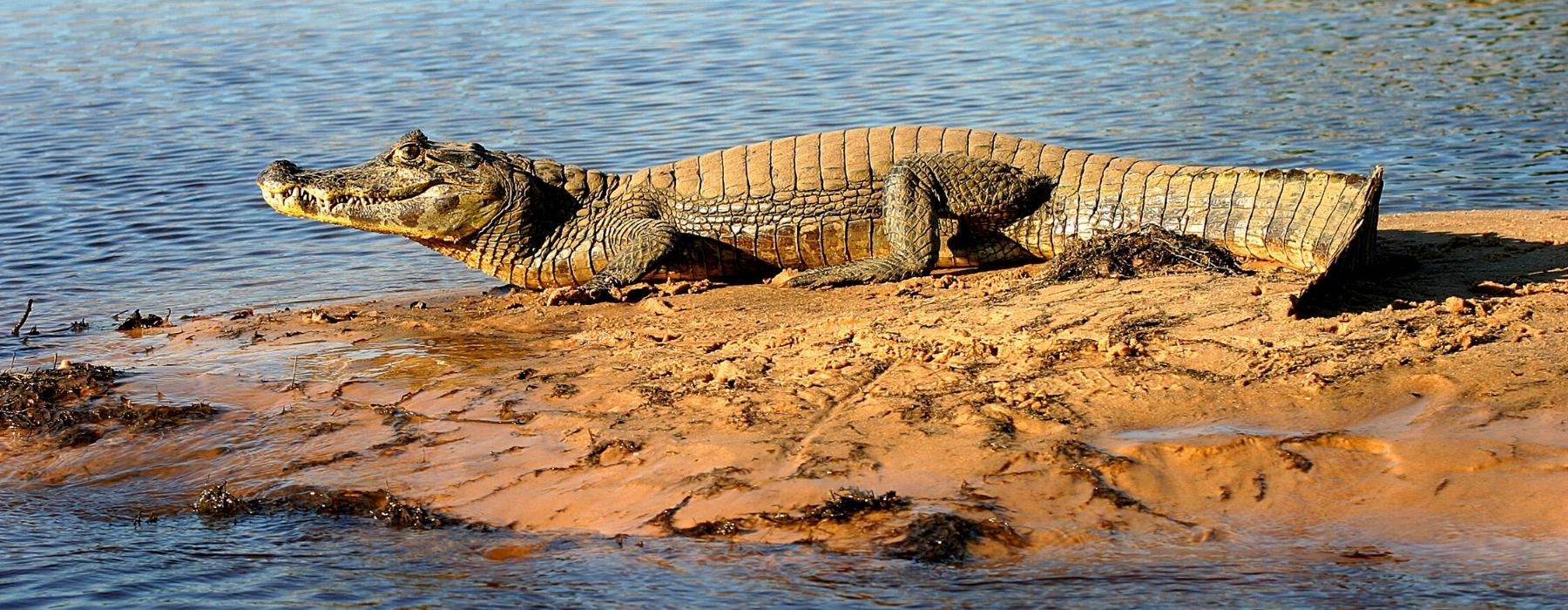
Manu Amazon Rainforest wildlife in Peru, a great tourist destination for its inexhaustible options for archaeological ruins with an incredible history behind them. It is also a great destination where you can appreciate the different wildlife it houses due to its great geographical diversity. Thanks to the fact that a large part of the Amazon belongs to the Peruvian territory, it is considered one of the countries with one of the largest biodiversity. But if it weren’t for its Amazon region, Peru would still have a large number of specimens to appreciate.
The largest rainforest in the world, the Manu National Park has a incredible biodiversity unlike anywhere else. full of exciting places to explore, its unique ecosystems combine to offer an unforgettable trip, and the strong desire to visit the wildlife in Peru again and again. The Amazon Rainforest is by far the most biodiverse area on the planet.
Amazon Rainforest animals set the fashion curve for South America. Some blend in with their surroundings, while others show off a wildly eclectic palate of bright colors, spots, and patterns. Folks from around the world travel to the Amazon with their long lens cameras and binoculars to see these unique critters.
In the Amazon Region of Peru, some 170 species of mammals have been recorded, most of which live in Manu National Park. Some of the most incredible animals of the Amazon are felines, monkeys, and river critters.
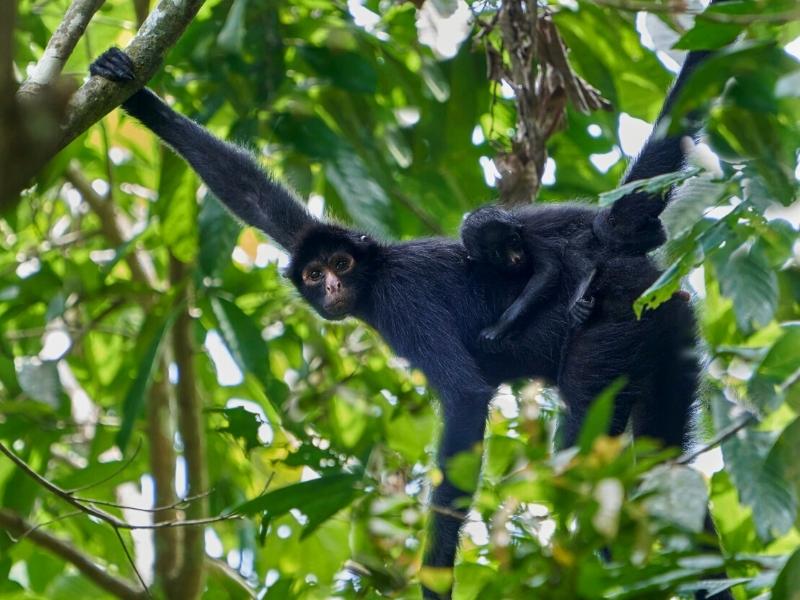
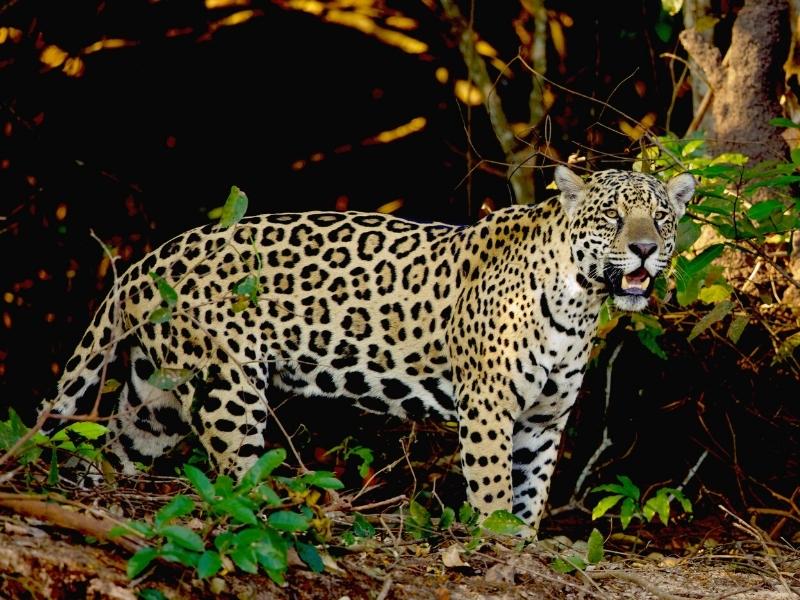
This beautiful big cat is the country’s largest feline, topping in size the Puma, Ocelot and Jaguarondi, Peru native animals that can also be seen in the same habitat. Jaguars are the apex predators in their environment, killing their prey with a powerful bite that’s strong enough to penetrate the skull and pierce the brain. Their jaws have double the biting strength of a lion’s.
A Jaguar’s spots are known as rosettes, because they resemble open roses. They differ from a Leopard’s because their rosettes have spots inside, whereas a Leopard’s don’t. Jaguars are found in Manu National Park, but they are probably easiest to spot along riverbanks when they come down for a drink. Sometimes they can also be seen lounging in trees above the water.
These are solitary animals, though, and very shy of humans, and their hearing is exceptional so they can avoid contact if they hear you coming. The males’ territories can extend to 90 square kilometres, so you need an amount of luck and patience to stay quietly in areas where local guides have pinpointed favourite haunts in order to see one of these awe-inspiring examples of Peru wildlife.
The best months to catch sight of Jaguars are May, June and July.
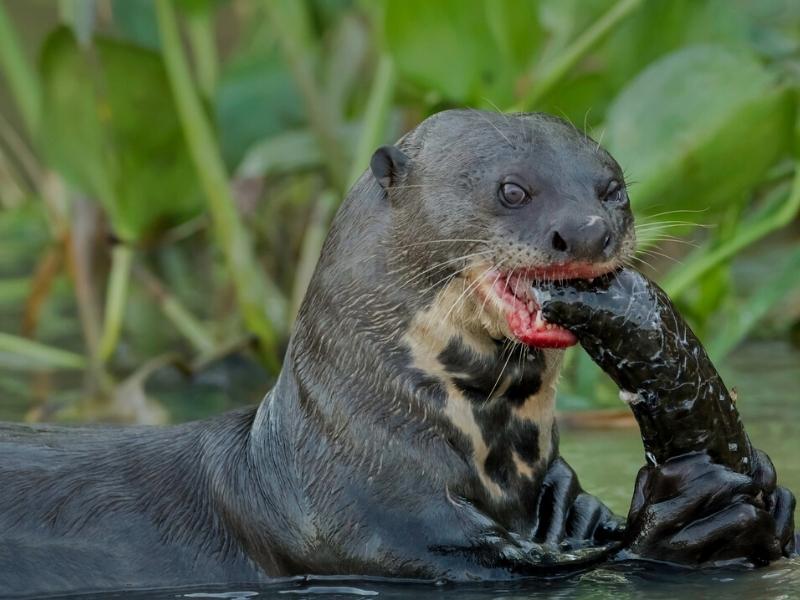
With their size and speed in the water, Giant River Otters have few predators. Jaguars are really the only Peru native animals these 1.8m-long freshwater mammals have to fear, although a large caiman or Anaconda can pose a challenge.
They are mainly fish eaters, although they will also dine out on crabs and water snakes, consuming around 3-4kg of food a day. They have excellent eyesight for effective hunting so locals call them ‘wolves of the river’. To raise their young they dig underground dens in riverbanks on slow-moving waterways. The young are born fully covered in water-repellent fur that even extends over their noses, and their nostrils and ears close up while they are swimming.
The white marks around a Giant Otter’s throat are unique to each animal, so individuals can be recognized from their fellows.
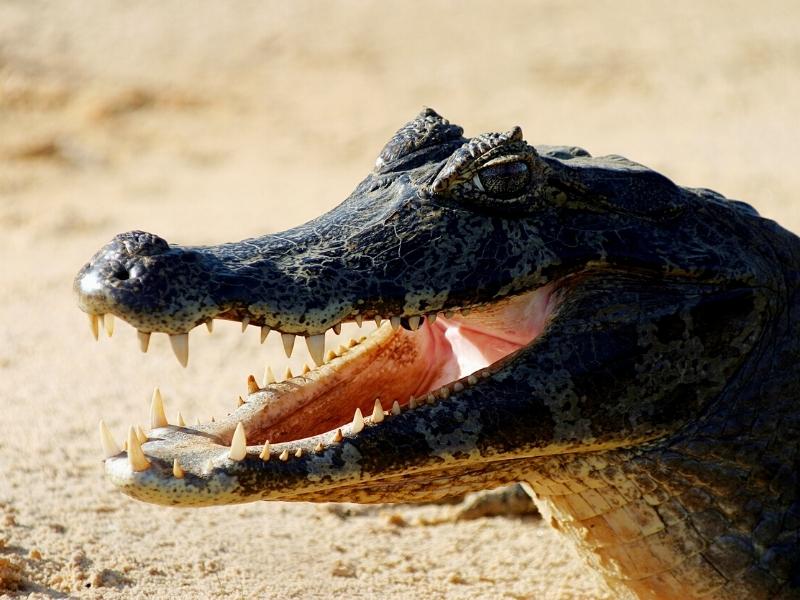
The name of this formidable reptile comes from the ridge of bone in front of its eyes that joins them to give it a look of wearing glasses. These expert hunters will eat almost anything fish, birds, insects, frogs, lizards, turtles and small mammals that venture into their river or lake environment. Larger ones have been known to tackle a Giant River Otter.
Although it is predominantly a freshwater species, the Spectacled Caiman can tolerate salt water, so long as it’s slow moving. They are happy in any depth where there is enough water to cover their bodies.
The best time to see them is in the morning or early afternoon when they tend to bask on the riverbanks. When the sun is heating, they will wallow in deeper water to stay cool.
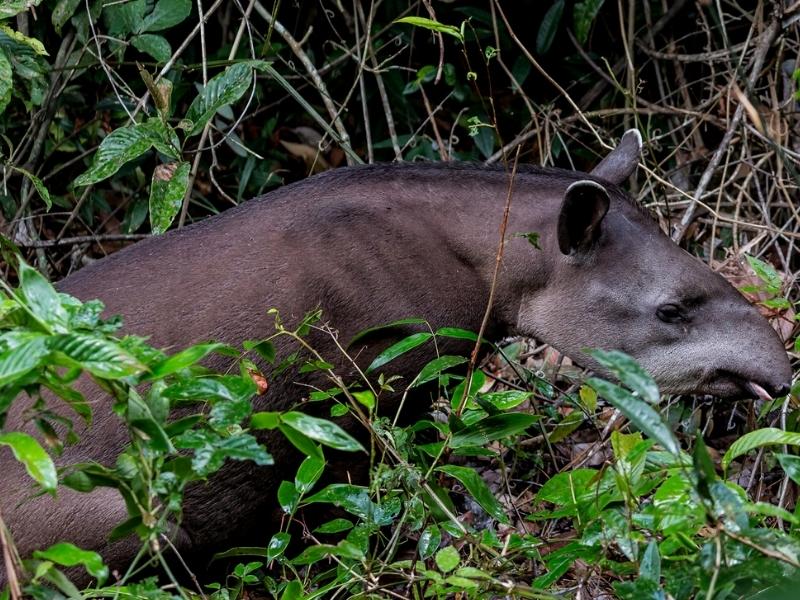
Although its general appearance and small trunk might lead you to believe that the South American Tapir is related to an elephant, or possibly a pig or a Hippo, it is actually more akin to a rhinoceros.
Tapirs are entirely vegetarian and use their sharp teeth and sensitive snouts to strip leaves, bark and thin branches. They cannot see very well but they have excellent hearing and a good sense of smell, and if they are frightened they can move at an unexpectedly remarkable speed, given their size and shape. They are also very good swimmers, which helps them escape if they are threatened by land-based Peru wildlife predators.
Tapirs supplement their diet with minerals gained from licking clay and so they can sometimes be seen at the same riverbank clay licks as the Amazon’s parrot populations.
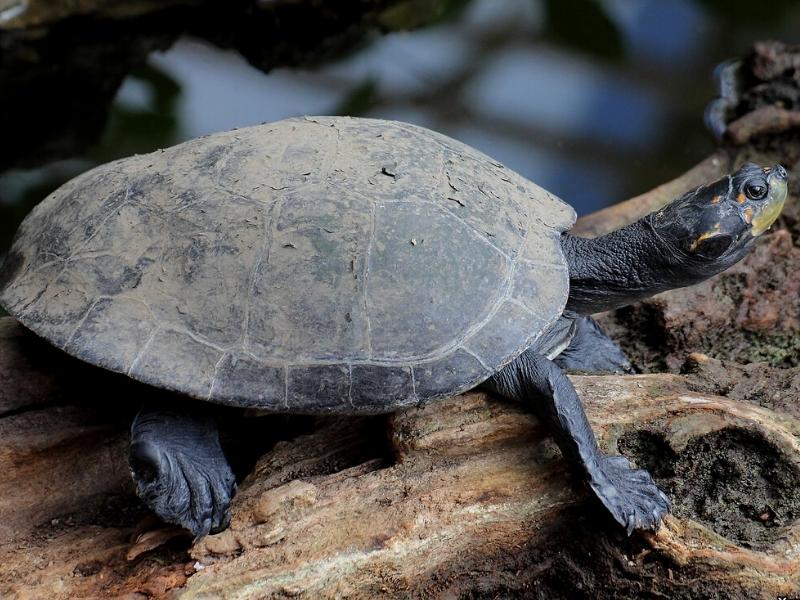
Taricaya turtles can be recognized by a black or brown oval shell with low keels on the second and third scutes. They are found in the jungle, specifically, in the tributaries and large lakes of the Amazon basin in South America. Their average lifespan is 60 to 70 years and they can grow up to 45 cm long and weigh up to 8 kg.
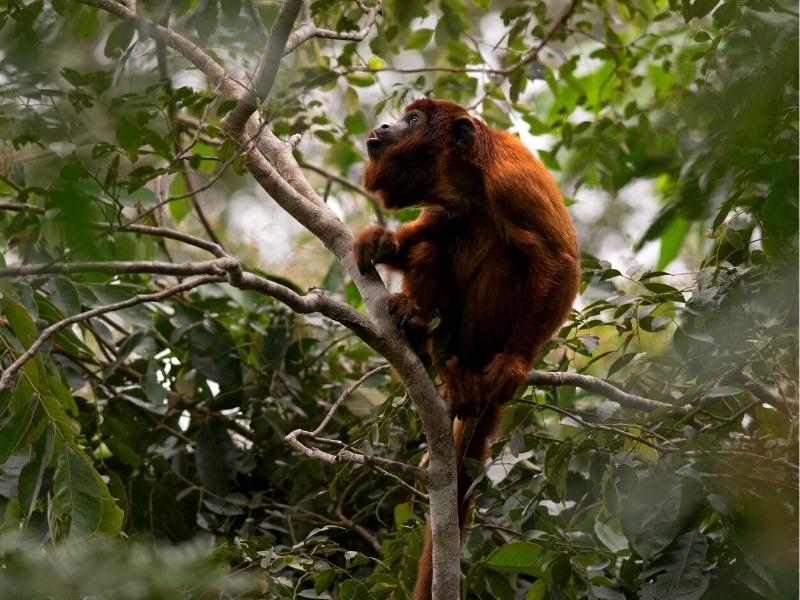
The red howler monkeys can be heard by most travelers visiting the Manu National Park. Their loud roars can be heard up to 3 miles (5 kilometers) away. There’s about a 50% chance to see these monkeys at our Manu Jungle Tours, with a greater chance the deeper you get into the jungle. Keep your eyes on the canopy!
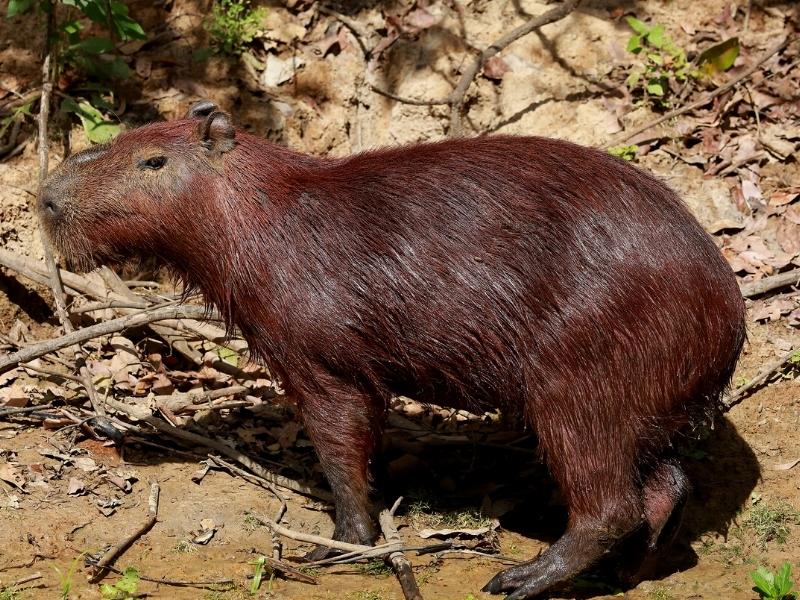
Its scientific name literally means “water pig“, since this animal (which has no relation to pigs) is basically a rodent.
Although it may seem incredible, these animals are close relatives of the ¡Rats!, the ¡guinea pigs! and rabbits! In that way? Well, as they are: rodents. More than thirty million years ago! Their ancestors already proliferated in this part of the continent. Some were much larger, enormous.
It is the size of a medium dog. It has wild boar hair and legs with interdigital swimming membranes. It has a ram’s snout and feeds on herbs. They are the most intelligent of rodents. In the face of danger they bellow (it is a powerful, hoarse cry). They flee in an organized fashion: the “ladies” in the lead, the males in the rear and the young protected in the middle of the group.
They walk in single file, in herds of up to thirty individuals (which increase due to births or decrease due to deaths). These herds maintain their composition for years. They are closed groups. Leaders are breeding adult males. They don’t have “patience” with “intruders” and if they have to fight, they do it with bites. They do not like to mix with other species in their territory.
They use the same paths over and over again, walking in “single file”. This continuous passage along the same paths gives rise to some characteristic ditches. When it comes to going to the “bathroom” they are extremely methodical: they tend to do it, generally, more or less in the same places and at the same time. On the banks they deposit piles of excrement. They can weigh up to 65 kg.
It is an animal with diurnal habits, but subjected to hunting by natives and settlers (its meat is highly valued) it can adopt nocturnal habits.
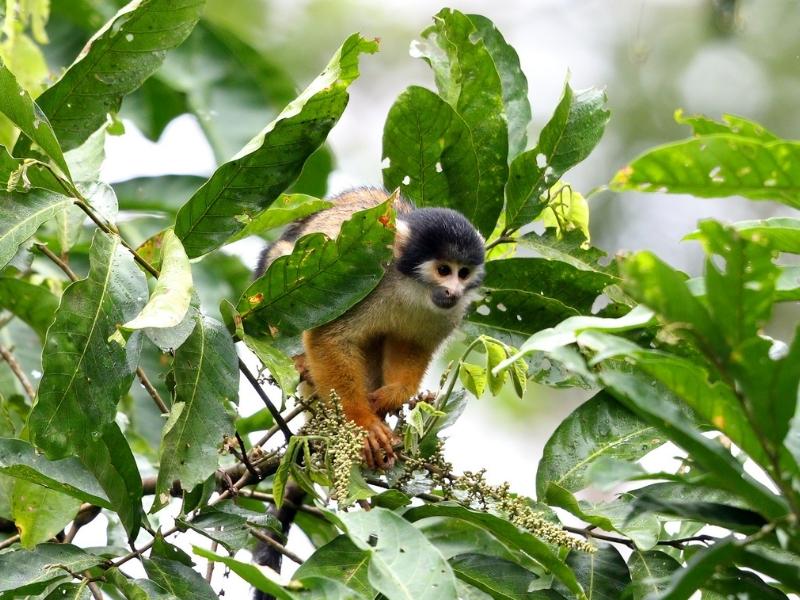
The black-capped squirrel monkey is found in the Manu National Park. They live in female-dominated groups with about 40 to 75 monkeys. Unlike many other monkeys that use their tail to climb, these squirrel monkeys typically use their tail for balance.

Sloths are known as Perezosos locally, meaning “lazy” in Spanish. Both the two-toed and three-toed sloths live in the Manu National Park. Some of the least-active animals out there, sloths sleep from 15 to 18 hours each day! Some even stay in the same tree their entire life.
Their huge hooked claws and lanky arms enable them to spend most of their time hanging from tree branches. Awake or asleep, they won’t lose their grip. In fact, researchers recently found that even after death they retain their grip! After they have died, sloths can sometimes be found hanging from tree branches just where they were when they were alive.
Being lazy and spending all of your time in a tree doesn’t exactly lead to the cleanest coat. If you’re wondering why these gray and brown-haired mammals sometimes have a greenish tint, it’s because their coats have a part-time job as a habitat for colonies of symbiotic algae! Their body has a deep groove for housing the algae, whose color is meant to help the animals camouflage with their environment in the Amazon’s rainy season.
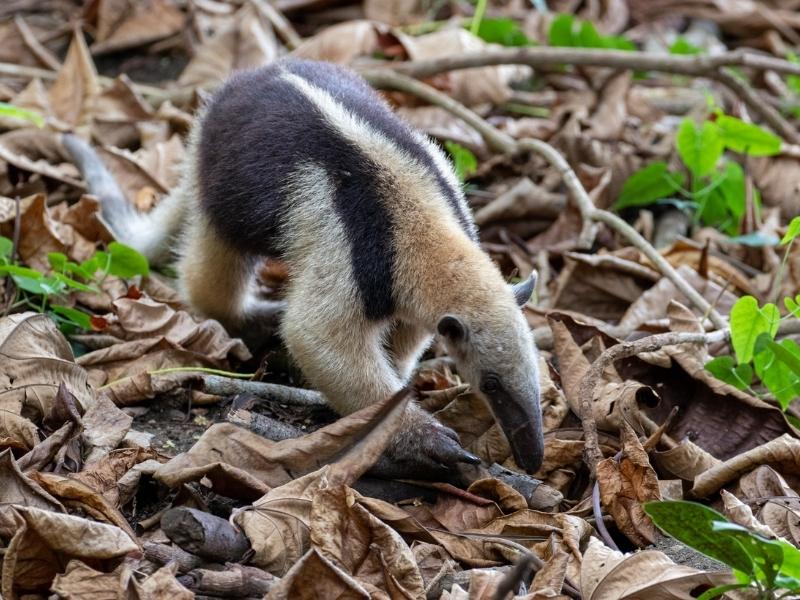
Anteaters are edentate animals—they have no teeth. But their long tongues are more than sufficient to lap up the 35,000 ants and termites they swallow whole each day. As the largest of all four anteater species, the giant anteater can reach eight feet long from the tip of its snout to the end of its tail. It is covered in grayish brown fur with white front legs, black stripes running from its chest to its back, and a bushy tail.
Giant anteaters can reach up to 2m in length and weigh up to 55kg – on its hind legs, giant anteaters are taller than a grown man. The giant anteater uses its sharp claws to tear an opening into an anthill and put its long snout, sticky saliva, and efficient tongue to work. But it has to eat quickly, flicking its tongue up to 150 times per minute. Ants fight back with painful stings, so an anteater may spend only a minute feasting on each mound. Giant anteaters never destroy a nest, preferring to return and feed again in the future.
These animals find their quarry not by sight—theirs is poor—but by their sense of smell, which is 40 times more powerful than that of a human. Giant anteaters are generally solitary animals. Females have a single offspring once a year, which can sometimes be seen riding on its mother’s back. Pups leave their mother after two years, when they’re considered fully grown.
Anteaters are not aggressive, but they can be fierce. A cornered anteater will rear up on its hind legs, using its tail for balance, and lash out with dangerous claws. The giant anteater’s claws are some four inches long, and the animal can fight off even a puma or jaguar.

With a graceful white mustache resembling German emperor Wilhelm II, the emperor tamarin belongs to a species of small monkeys and is mostly found in the forests of South America. Its name was first mentioned in jest before it was incorporated in connection with the mammal. It is highly identified by its small body size and long, thin tail, and its grey coloring is accented with bits of red and orange on its back and chest.
The emperor tamarin is diurnal, meaning that it is most active during the day and sleeps through the night. This creature is known to be an omnivore, with its diet primarily comprised of fruits, tree sap, insects, small reptiles, eggs, and nectar.
It’s known to exist in groups of 4 to 20. Each group has an elderly female as its leader, and each has its marked territory. These animals use hissing sounds as well as chirping calls to communicate.
Emperor tamarins are known to be very sociable creatures and live with the rest of their troops in a marked territory. A troop, or group, can range anywhere between 4 to 20 tamarins. Such groups are usually led by the eldest female members and also have predominantly male members. It has also been observed that these tiny species are very loving and affectionate towards the humans they come in contact with. They maintain a close-knit relationship with all the members of their group and cordially cooperate. They are also known to sleep, feed, collect for, and protect their marked territory together.
Emperor tamarins are omnivorous, meaning they eat both plants and animals to survive. Fruits, eggs, nectar, and insects are some of the things that primarily make up their diet and primarily come from the trees they reside in.
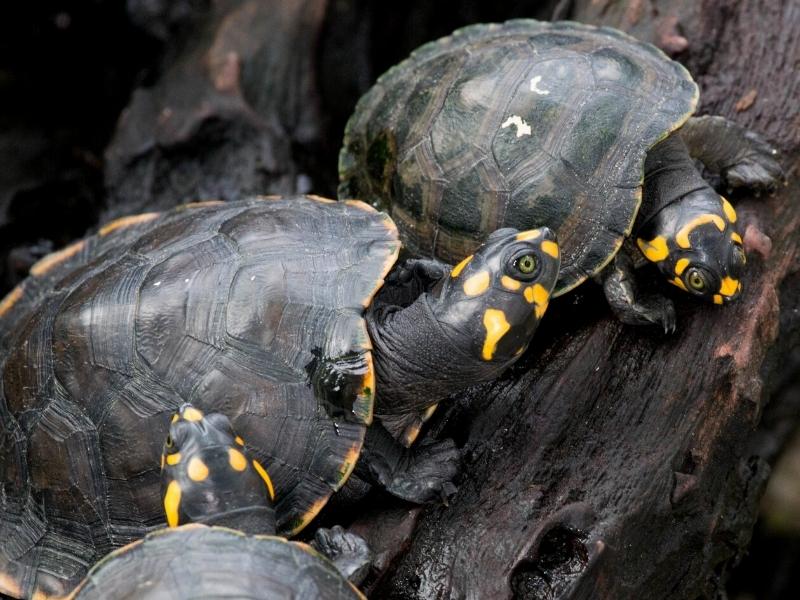
The yellow-spotted turtle has a domed and dark colored shell. They have yellowish-orange head markings. There is usually a single barbel on the chin. These side-necked turtles cannot retract their head into their shell. Hatchlings have very obvious yellow spots on their heads, which shrink as they grow. Males keep some of the yellow spotting; females lose their spots altogether.
The average adult length is 15 to 27 inches (38 to 69 centimeters), with females outgrowing males. Adult males weigh 1 to 2 pounds (0.5 to 1 kilograms) and females weigh 2.5 to 6.5 pounds (1 to 3 kilograms).
These turtles spend time basking along the riverbanks and in the calm waters of big rivers and streams. They avoid fast-moving waters. They are omnivorous, feeding on both vegetation and small animals. They have also been known to occasionally use an inertial feeding mechanism to extract fine particulate matter from the water surface. The turtles are diurnal, meaning they are most active in mid-morning and afternoon.
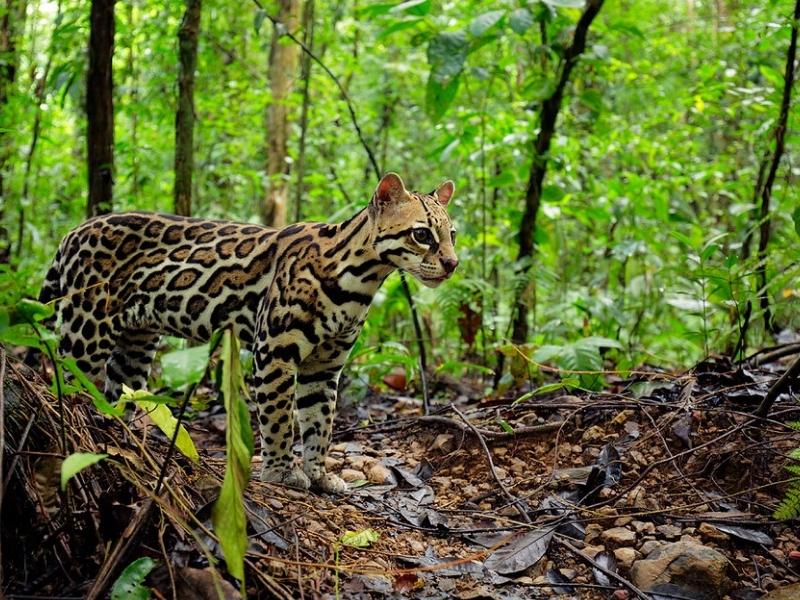
Feline mythologized by pre-Hispanic cultures such as Paracas, Nazca, Inca, Ancón, Chancay and Tiahuanaco. It is a medium-sized feline, with huge eyes, short and soft yellow-brown hair with rosette black spots and longitudinal lines. Its neck has intense black bands. It has long legs, the front ones are wider than the back ones. It is terrestrial and solitary, it is rare to see it climb trees. Its habits are diurnal and nocturnal, being more active at night. It feeds on rodents, birds, snakes, lizards and other small mammals. It usually leaves marks of its claws by sharpening its nails on the bark of trees.
Since time immemorial, the tigrillo or ocelot lives in the Amazon forests. This species may have been domesticated and held as a living deity. Currently the pressure on its habitat and the traffic to which it has been subjected, has put it in danger in Peru, considering it a species in a vulnerable state. Worldwide, the tigrillo or ocelot is registered in the red book of endangered species.

The peccary, (Pecari tajacu) is a species of artiodactyl mammal of the Tayassuidae family. It is found in the Peruvian Amazon. It has a height of half a meter, a length of 70 to 110 cm, and a tail of 2 to 5 cm.
It is characterized by its blackish-brown bristle coat and a white spot that resembles a necklace at the base of the neck. On the back it has a 12 to 1 cm glandular cavity from which it secretes an oil with a musky odour. It feeds on fruits, tubers, grasses, invertebrates, small vertebrates. It inhabits xerophytic and desert forests, tropical and subtropical grasslands, savannahs, scrublands, flooded savannahs and grasslands, tropical and subtropical broadleaf forests, as well as other habitats.
They are diurnal animals that live in groups of 1 to 20 members, but on average between 6 to 9 members generally. They sleep at night in burrows, or often under tree roots. Although they are usually unaware of human presence, the peccary could react if threatened, using their long fangs that sharpen themselves when they open and close their mouths.
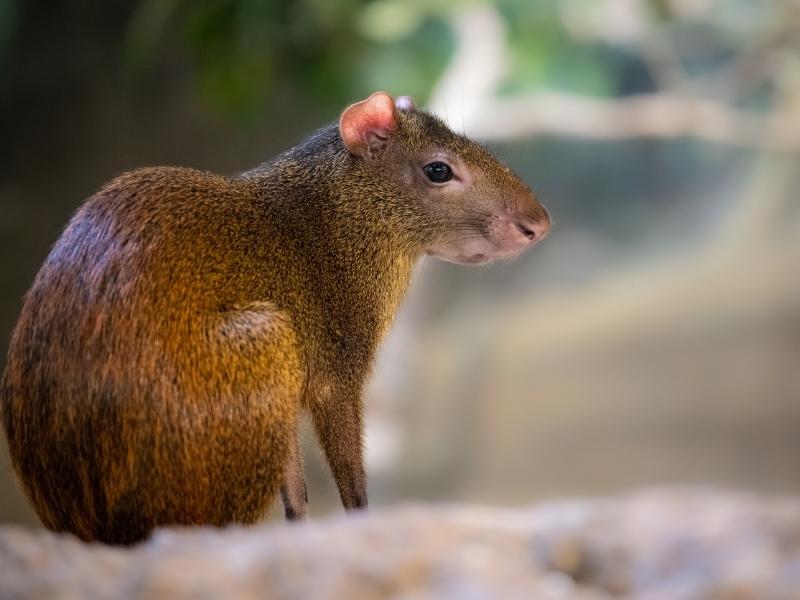
It is a species of hystricomorph rodent of the Dasyproctidae family found in the Manu National Park.
The length of its body ranges from 42 to 62 cm; its weight from 2 to 3 Kg. The coat is reddish brown, darker in the upper parts, with a 1 to 3 cm tail. The hind legs are 12 to 14 cm long with three toes. On the foreleg it has 4 toes and a vestige of a thumb.
The upper coat is grey-blackish, longer on the back; on the underparts it is brown to yellow and white. It is diurnal, but adopts nocturnal behavior if it feels threatened.
It feeds mainly on fruits, although it also consumes seeds, some herbs and tubers. The eating habit of the añuje is based on palm fruits, roots complemented with cassava, corn, pumpkins, and fodder. It buries seeds in its territory and in times of food scarcity they depend on those buried seeds.
A pair occupies an area of 2 to 3 hectares that it defends. It uses as shelter burrows that it digs in the ground, or between the roots of the trees or that it finds between the rocks.

The short-eared dog can be considered one of the rarest carnivores in the entire Amazon. Since the species was described at the end of the 19th century, almost nothing has been published about the ecology of the species. In the 1960s, biologists collecting mammals in the Peruvian Amazon reported that the species was relatively common. Starting in 1970, the species practically disappeared from the region, probably due to some disease, only to appear again later. Since 2000 the first author and other biologists have studied five different individuals at the Cocha Cashu Biological Station. In 2002, three different individuals were observed in the Alto Purús region.
Although there is not yet sufficient data for a population estimate, the abundance of this species appears to be relatively high in these two areas compared to the rest of its geographic range. Through their tracks, it has been possible to identify some types of habitat used by the species and estimate the number of individuals in a certain area. It was also possible to obtain data on diet, interactions with other fauna species, circadian activities and reproduction period.
Based on the analysis of 30 fecal samples and visualisations, it was observed that the dogs fed mainly on fish, but also ate fruit, small mammals, toads and invertebrates. At one site, dogs were observed using the same latrines as the otter, Lontra longicaudis. It was also observed that the species uses hollows made by the majaz, Agouti paca, as burrows.
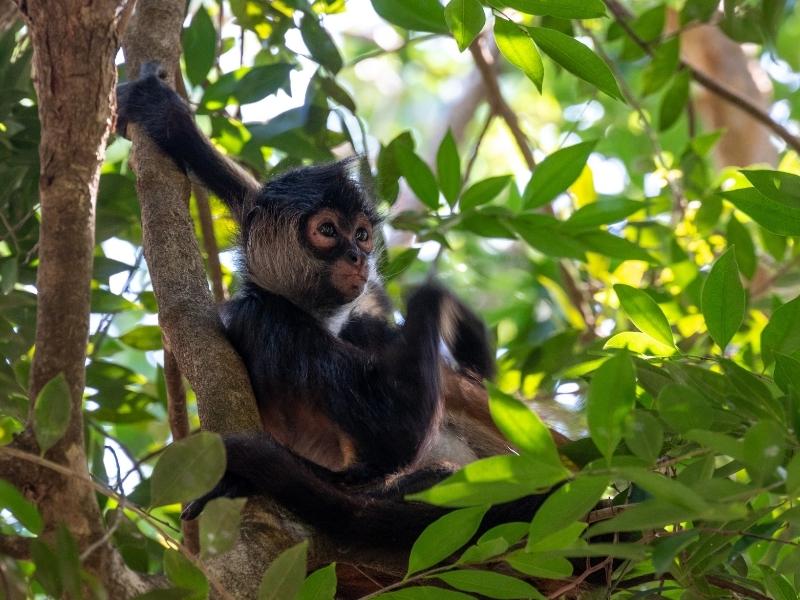
Black-faced black spider monkeys are diurnal and are typically found in social groups with approximately 5 to 25 animals per square kilometer in hunted areas and up to 80 animals per square kilometer in non-hunted areas. Less individuals per square kilometer are usually present when there is competition with other species of primates. In addition to competition with other primate species as a factor determining population densities, food abundance tends to be the biggest predictor of abundance of black-faced black spider monkeys. Because of this, social parties are usually larger in the wet season than in the dry season. Average social group size tends to be approximately 3 individuals.
Typically social interactions between groups tend to be peaceful, with males settling territory disputes should they arise. Party composition is usually stable with members of the party able to recognize each other. Social party membership does change when individuals leave or join the social group. Social grooming typically occurs between females and their offspring rather than between mates. Through observation, researchers have found Ateles chamek individuals spend approximately 30% of time feeding, 44% of time resting, and 25% of the time moving.
Species-specific information about the communication patterns of Ateles chamek is limited, however, like other spider monkeys, black-faced black spider monkeys communicate vocally through grunts, howls, or screams. Additionally, mates may recognize each other through smell. Spider monkeys also shake tree branches, and signal each other by swinging their arms.
Black-faced black spider monkeys are predominantly frugivores, spending large amounts of time forging for fruits. They supplement their diets in times of low fruit availability with flowers, insects, and leaves, and will occasionally consume insects such as a caterpillars.

Common wooly monkeys are large robust animals and are one of the largest New World primates by weight. Males are generally heavier than females, and male canine teeth are significantly larger than those of females. The hair is dense, short, thick, and predominantly composed of underfur.
In older individuals there is a fringe of longer hair on the rear of the arms and legs and on the under belly. Color varies greatly with the upperparts being dark brown, pale smoky brown, dark gray, pale gray, red-brown, or olivaceous. In some common woolly monkeys the color of the head and limbs is distinctly darker than that of the back, in others the color is uniform.
Larger groups are a collection of family units that may feed and travel together or travel separately, only coming together to sleep at night. Males threaten other males by shaking branches, defecating, and by barking loudly. Common wooly monkeys often groom each other, adult males receive the most grooming. Adult females are usually groomed by their juvenile daughters. Juveniles in a group play with each other around midday and they seem to have their own games. Communication can take place by vocalization, facial expression, or other visual behaviors. Common woolly monkeys can show subtle changes in mood and intention by employing a variety of facial expressions.
Their calls are often loud, and can be like barks or screams. These calls are often musical and can serve to alarm the rest of the troop. In their natural habitat, and in captivity, common woolly monkeys have been observed to rub their chest. It has been mostly observed in dominant males when moving into a new territory. After sniffing the ground and licking the new location, the chest is pressed against the ground at the level of the nipples. This behavior is performed several times and the nose is applied to the marked spot each time.
Consumption of leafy material accounts for probably less than 20% of their diet. A large part of their feeding time is spent eating ripe fruit. Seeds are most important early in the rainy season when ripe fruit is not readily available. During July in Amazonian Brazil, insects comprise an important part of the diet. In captivity, female common woolly monkeys were observed to prey on sparrows and were observed to share some of the prey. Higher ranking animals in a troop often take food from lower ranking anima
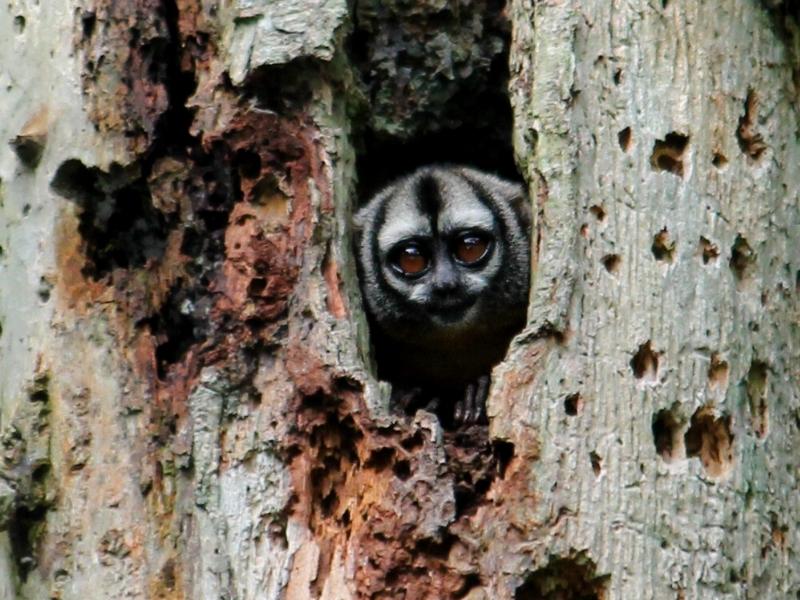
Black-headed night monkeys are usually found in lowland and hillside tropical forest areas. They are usually found in the higher canopy levels of the forest. They choose exclusive sleeping sites in the crooks of branches, especially in trees in the genus Miconia. These trees have large leaves and relatively thick canopy cover.
Black-headed night monkeys are small primates approximately the same size as a small squirrel. While there are few data concerning the mass of A. nigriceps specifically, Aotus species, both male and female, average 750 g as adults, reaching this size by 14 months of age. Their coats are short and thick. Adult A. nigriceps have dark grey-black agouti pelage on the upper back and forelimbs and orange-tan pelage on the lower back, outer rear legs, and onto the tail.
They have three conspicuous black stripes that nearly converge on the forehead. Two of these stripes follow the sides of the face to the maxilla, the central stripe extends to the bridge of the nose. They have white patches over each eye, on the cheeks, and under the mouth. They also have bright orange pelage on the sides of the neck and onto the ventrum, extending from the lower neck, chest and stomach onto the arms, legs and ventral tail. Infants and sub-adults have the same basic coloration.
Aotus species have disproportionally large, brown eyes, consistent with their nocturnal habits. They lack a tapetem lucidem. Night monkeys have small external ears that are hidden by their fur. Their digits are long and thin, with straight nails and wide fingertip pads.
Black-headed night monkeys are arboreal quadripeds. They are primarily nocturnal, but have been occasionally observed during daylight hours. Black-headed night monkeys live in small family groups, including their young and sub-adult offspring. Aotus nigriceps individuals are highly territorial and defend their range with vocalizations and sexually specific aggression. Males usually attack other males and females usually attack other females. Confrontations last from 5 to 30 minutes and end when one of the groups leaves. Aggression is also the means of mate displacement. A male or female will enter a territory and fight with the resident female or male.
Black-headed night monkeys are primarily frugivorous, preferring ripened Ficus fruits. They also opportunistically feed on leaves and flowers as well as moths, beetles, and spiders.
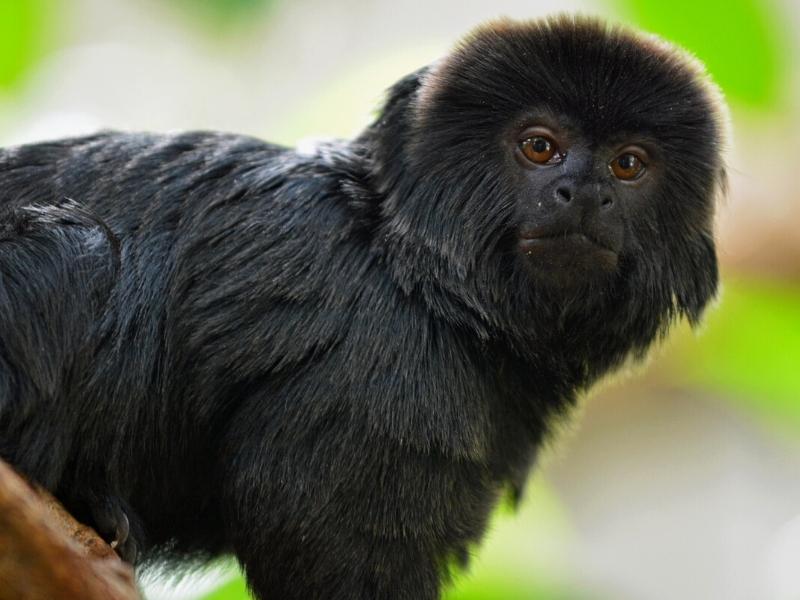
Callimico goeldii generally stay within 5 meters of the forest floor and travel to higher elevations in order to obtain fruit. They sleep close together “in dense underbrush or in a hollow tree“. They also rest in a dense group roughly 3 times per day at an elevation of less than 2 meters in “dense brush or on inclined trunks of fallen trees”. Resting periods average 30 to 90 minutes, where Goeldi’s monkeys may sun bath or groom.
Callimico goeldii exhibit extensive social communication through vocalizations, scent, facial, and body language. Vocalizations include long distance cries that are effective over 100 meters and ultrasonic sounds. Scent glands on the stomach are used when they “stretch their limbs, arch their backs, and thrust the coiled tail under their body, moving it back and forth over the ventral surface, which is thereby moistened with urine and scents.
The diet of Callimico goeldii consists primarily of fruits, insects, and small vertebrates. A group of Goeldi’s monkeys will travel and feed in fruiting trees. Competition for fruit seems not to be a problem. They hunt individually, leaping to the ground to obtain small vertebrates.
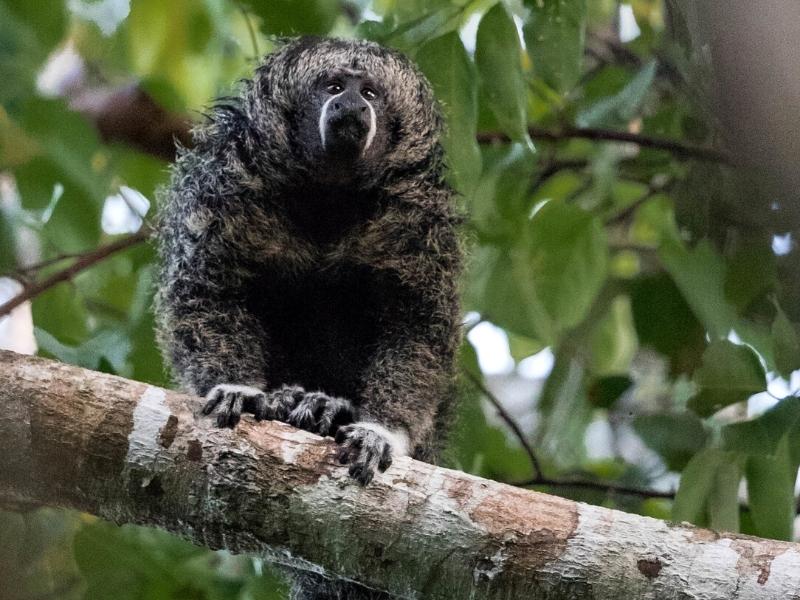
Gray’s bald-faced sakis are medium-sized monkeys with a memorable presence thanks to their distinctive pelage. Long dense hair gives a shaggy and unshorn appearance. Although their color reads as “grizzled” gray, their hair is actually black with long bands of white. There is some white hair above their dark brown eyes and light-colored hairs form distinctive “bangs” above the eyes. Their faces are unpigmented—appearing gray/pink in color—and get darker with age. As their names suggest, they have less hair on their faces than most other saki species.
Their hands and feet are covered in white hair, although their forearms tend to be brown and adult males have a distinctive orange ruff. Their tails are thick and hairy. These tails are non-prehensile, meaning they can’t be used to grip branches like the tails of spider monkeys or capuchins.
Coloration can vary with geographic region, with females in the Acre region often appearing lighter in color than females elsewhere.
Sakis are frugivores; their diet generally consists of over 90% fruit, although they also eat leaves, flowers, and insects. Gray’s bald-faced sakis show a specialized form of frugivory, because they feed primarily (over 80% of the time) on the seeds of unripe fruits. Since unripe fruits are more available than ripe fruits throughout the year, this allows them to maintain their diet even when ripe fruit availability is low—and also avoids competition with other fruit-eating animals. Their strong teeth help them to break into the unripe fruits and their diet includes over 200 different plant species.
Gray’s bald-faced saki monkeys are arboreal and diurnal primates; they sleep high in the trees at night and are active during daylight hours. They spend all their time in the trees and do not venture down to the forest floor. These sakis spend around 50% of their time foraging, with the remainder of the day spent resting, moving, or engaged in social activities, such as grooming and playing.
While they tend to ignore smaller species of primates with whom they share habitat, they will go out of their way to avoid larger or more aggressive primate species, such as spider monkeys or capuchins.

Dive deep into the culture and landscapes of Peru with this adventure to Machu Picchu, the Amazon and more. Search for wildlife along jungle trails and rivers in the rainforest from a comfortable lodge then head up into the Andes to Cusco, the capital of the Inca empire.


Your luxury trip to Peru includes a selection of Andean and Amazonian landscapes. We will help you to explore this welcoming and varied country, planning each step of your trip, with the best services. With the help of amazing expert guides, you can enjoy all that Peru has to offer, every detail is well taken care of.


Peru is a country with different cultures and beautiful landscapes. It has one of the best gastronomy in the world. This tour is designed for travelers looking for unique and special moments in their vacations, and families who want to avoid crowds. You will visit the ancient city of Lima, the Amazon forest, the beautiful sacred valley of the Incas, the wonder of Machu Picchu.


Manu National Park is an excellent way to experience an intense amazon wildlife.Is the biggest Amazon rainforest in the Americas, its incomparable natural wealth, host the greatest amount of flora and fauna of the world.

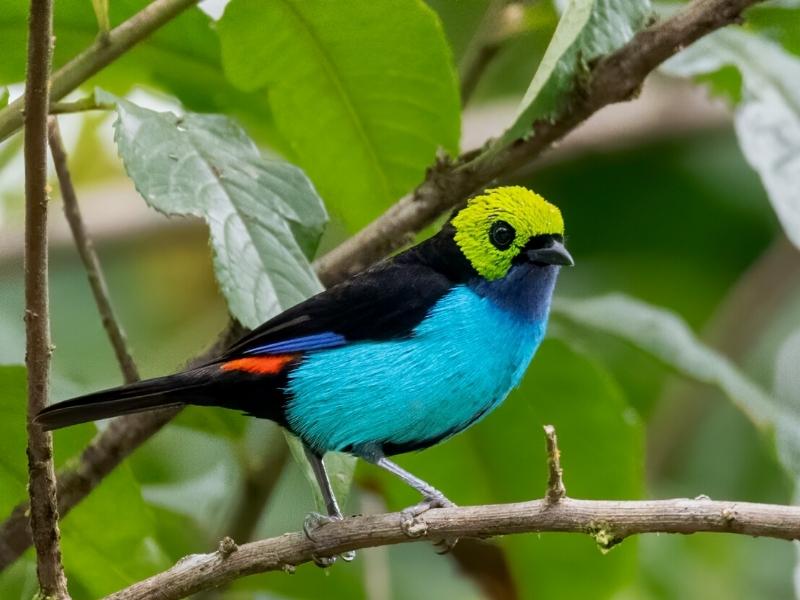
Manu National Park is located in the Amazon rainforest of Peru. This attraction is one of the few places on the planet that still maintains its great biodiversity of birds, mammals, reptiles and many medicinal plants.


Explore Manu National Park 5 days, the amazon’s mystery and Live a fascinating adventure to the vast amazon Manu national park , is one of the best places in South America to see a stunning variety of tropical wildlife.


This trip allows you to have one of the best experiences in the Manu National Park which includes the Reserved Zone in only 7 days. It is an ideal way to experience the culture and traditions of local communities and see the distinct species of animals and birds that inhabit here.

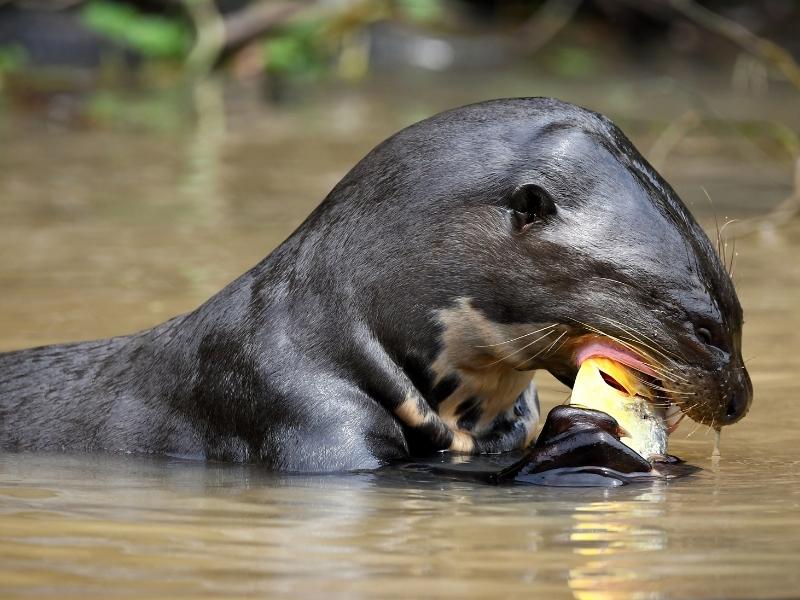
Discover the majestic Amazon rainforest of the Manu National Park. This protected area is in Peru, it is one of the largest ecosystems on the planet, due to its great diversity of birds, insects, plants and mammals.


The Manu Jungle tour goes to one of the largest life biosphere reserves in the World. You will enjoy wildlife, traditional villages, with the best specialized guides.
